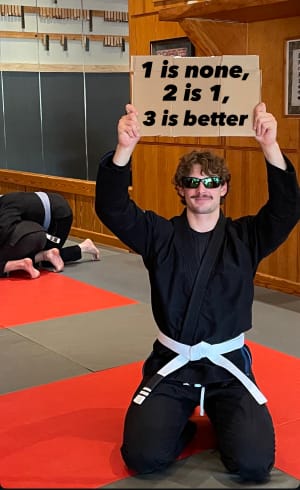
Building Resilient, Adaptive Systems for Self-Defense and Jiu-Jitsu In martial arts—especially self-defense and Jiu-Jitsu—having just one answer to a problem is like having a single spare tire when you blow out two wheels. You’re still stuck. When your opponent counters your one and only move, your whole plan falls apart. That’s why, at Quest Jiu-Jitsu & Self-Defense, we say: “One is none, two is one, and three is better.” This principle applies not just to tactics, but to your whole approach to learning. Let’s explore how building multiple, layered solutions gives you a deeper, more adaptable, and more powerful system—one that can flow, redirect, and surprise under pressure. Imagine this: you’re mounted, and you’ve drilled the trap-and-roll escape a hundred times. But what happens when your opponent posts their arm wide, neutralizing your bridge and trap? If you only have one technique for escaping mount, you’re done. In real-world self-defense or in sparring, the danger isn’t just that your technique fails—it’s that your decision tree ends abruptly. You’re stuck. That’s why we train with the mindset that one technique is not enough. A single strategy might be fine against a white belt or an untrained attacker, but against someone skilled, committed, or simply unpredictable, you'll need options—fast. Now let’s say you’ve got both the trap-and-roll and the elbow escape in your mount escape toolkit. These two techniques complement each other beautifully: The trap-and-roll works when your opponent is upright and posting weight on their hands. The elbow escape works when they are low and heavy on your hips. One counters the other’s counter. When trap-and-roll fails, it creates the conditions that make elbow escapes easier. You can now bounce between them, forcing your opponent to stay reactive while you stay proactive. This is the essence of good self-defense and smart Jiu-Jitsu: developing complementary tools that let you flow, shift direction, and adapt to resistance and circumstance. So, why not stop at two? Because in fighting, just like in life, patterns emerge—and experienced opponents learn to recognize and exploit them. Once your two-technique cycle becomes predictable, they start timing your transitions, shutting down both options. Enter your third solution. This third move isn’t just “one more technique.” It’s your disruptor. It allows you to break patterns, shift rhythm, and carry the momentum forward when resistance increases. Think of it this way: You attempt a body lock takedown. Your opponent retreats their hips to maintain their base and stay upright.. You switch to an uchi-mata, attacking in a way that exploits their widened base. They counter the throw by posting their hands on the ground—so now you spin into a front headlock, capitalizing on their reaction and momentum to transition into a dominant position. Your third option doesn’t just solve a problem—it keeps the fight evolving. This kind of tactical variety overwhelms defenses and opens up space for domination or escape. This concept doesn’t stop at escapes or takedowns. It’s a way of structuring your game. Instead of memorizing isolated moves, start building three-technique systems or “hubs” around your favorite positions. For example: From Butterfly Guard: Lift and sweep, if they press you down, scoot to Lazy Butterfly, and if they stand transition to Shin-to-Shin. Each position should offer one control-based option, one reactive/counter-based option, and one transitional option that lets you flow into the next phase, dominant position, or safe space. Now your game is no longer linear. It becomes cyclical, adaptable, and strategic—qualities that make the difference in high-level rolling and real-world defense. As you develop, your favorite techniques and go-to systems will change. Injuries, experience, training partners, and even your physicality will shape how you move and what you rely on. That’s normal. That’s good. The key is to keep the concept alive: Don’t fall in love with any single solution. Build layers and the ability to move between them. Develop systems that flow naturally for you. And above all, stay flexible. At the end of the day, no technique is guaranteed to work every time. All martial artists—especially self-defense-minded ones—should remember: “Your results may vary.” What matters most is your ability to adapt freely and naturally.One is None, Two is One, and Three is Better
One Is None: The Danger of a Single Option
Two Is One: Complementary Techniques Create Flow
Three Is Better: Creating and Breaking Patterns
Systems, Not Just Techniques
Adaptation Over Perfection
If you’d like help developing your own three-technique systems or want to experience how this principle works in action, come train with us at Quest Jiu-Jitsu & Self-Defense. We’re not just teaching moves—we’re leaning into the spirit of “Mugen Budo”, the limitless path of the warrior.

